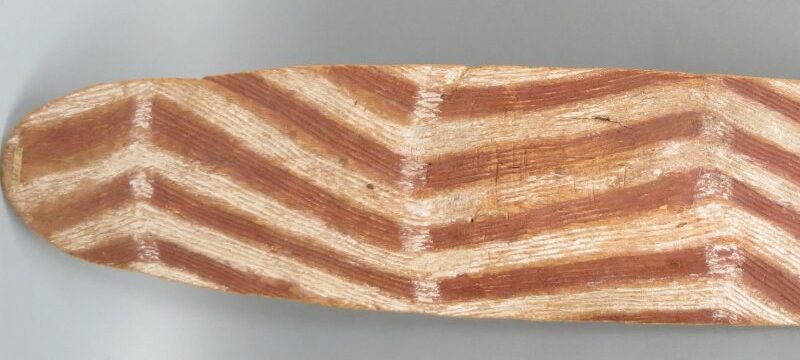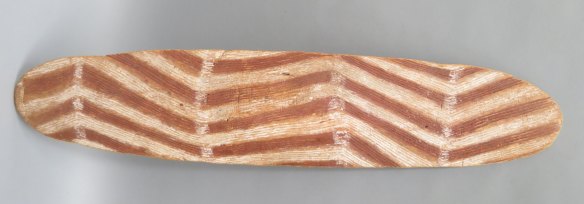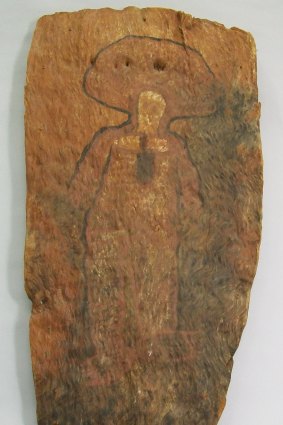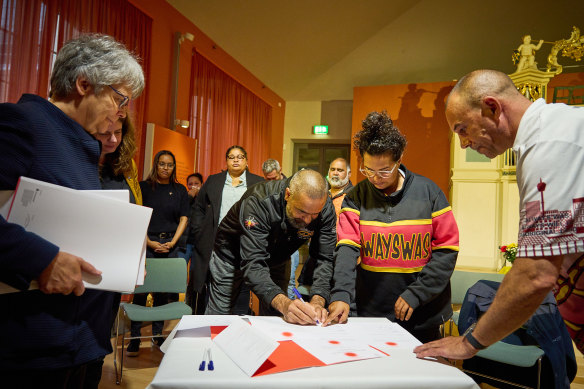Save articles for later
Add articles to your saved list and come back to them any time.
Dozens of historically significant Indigenous cultural artefacts are set to be returned to their traditional owners under a landmark deal being arranged between the German and Australian governments.
It is believed the transfer would be the first official return of Indigenous cultural items from continental Europe to Australia.
The Ethnological Museum in Berlin has dozens of Aboriginal artefacts in its collection, many purchased from explorer Emile Clement.
Sources said around two dozen objects housed in German cultural institutions – including shields, woven bags and necklaces – have been identified as high priority for return to Australia.
German ambassador Markus Ederer said the German government regarded the issue as significant and he expected it to be raised in high-level meetings between German and Australian officials this year.
“We are very advanced in terms of the return of human remains and we would like to move on to the return of cultural artefacts,” Ederer said in an interview.
Prime Minister Anthony Albanese will travel to Berlin next month to meet with German Chancellor Olaf Scholz and German Foreign Minister Annalena Baerbock is scheduled to visit Australia later this year to meet with Foreign Minister Penny Wong.
A spokeswoman for the Australian Institute of Aboriginal and Torres Strait Islander Studies (AIATSIS) confirmed it was submitting an official request for the return of Aboriginal cultural heritage material from one institution in Germany.
“If this request is successful it will be the first return of cultural material under the Return of Cultural Heritage program from continental Europe,” the spokeswoman said.
“It may be the first return of cultural heritage material to Australia from continental Europe.”
An Aboriginal bark painting that forms part of the Ethnological Museum of Berlin’s collection of Indigenous artefacts.
The AIATSIS spokeswoman said the government-funded institute is “aware of items of particular significance that are held in German institutions”.
“This may include men’s restricted material and unique items collected from communities in southern Australia,” she said.
“AIATSIS welcomes the return of Aboriginal and Torres Strait Islander people’s cultural heritage material from Germany and looks forward to continuing discussions with the German government and German institutions.”
The institute’s return of cultural heritage initiative has previously repatriated 42 objects from the United States, 43 objects from the United Kingdom and 1800 artefacts from Israel.
The Ethnological Museum of Berlin has a significant collection of Indigenous Australian artefacts, including several items purchased from German ethnographic collector Emile Clement in 1898.
Australian Indigenous community leaders sign the paperwork taking custody of six ancestors from the Grassi Museum of Ethnology in Leipzig, November 17, 2022.Credit: Australian embassy, Berlin
These include boomerangs, headdresses, spear throwers, tobacco pipes and a fruit kernel necklace that Clement collected during research expeditions to Australia in the late 1800s.
The museum collection also includes several artefacts purchased from German anthropologist Helmut Petri in 1964.
The Grassi Museum of Ethnology in Leipzig has a collection of Australian material that includes 4600 objects including traditional Indigenous paintings, shields and stone artefacts.
Germany’s repatriation efforts are part of a push across Europe for cultural institutions to return cultural artefacts and human remains that were often plundered without permission.
Germany has begun returning hundreds of artefacts known as the Benin Bronzes to Nigeria that were looted from West Africa more than 120 years ago.
German collecting institutions have returned the remains of over 150 Indigenous ancestors to Australia since 2013, although thousands of scalps, shrunken heads, mummies and flutes made of bones remain in German anthropological museums and university collections.
Cut through the noise of federal politics with news, views and expert analysis from Jacqueline Maley. Subscribers can sign up to our weekly Inside Politics newsletter here.
Most Viewed in Politics
From our partners
Source: Read Full Article



